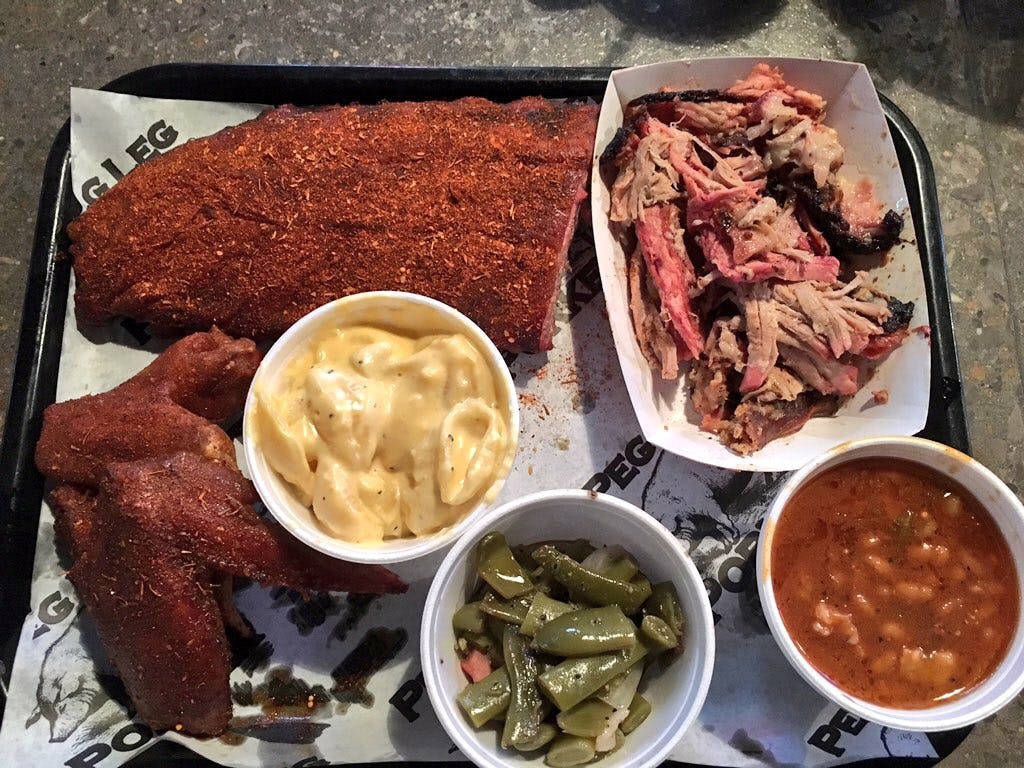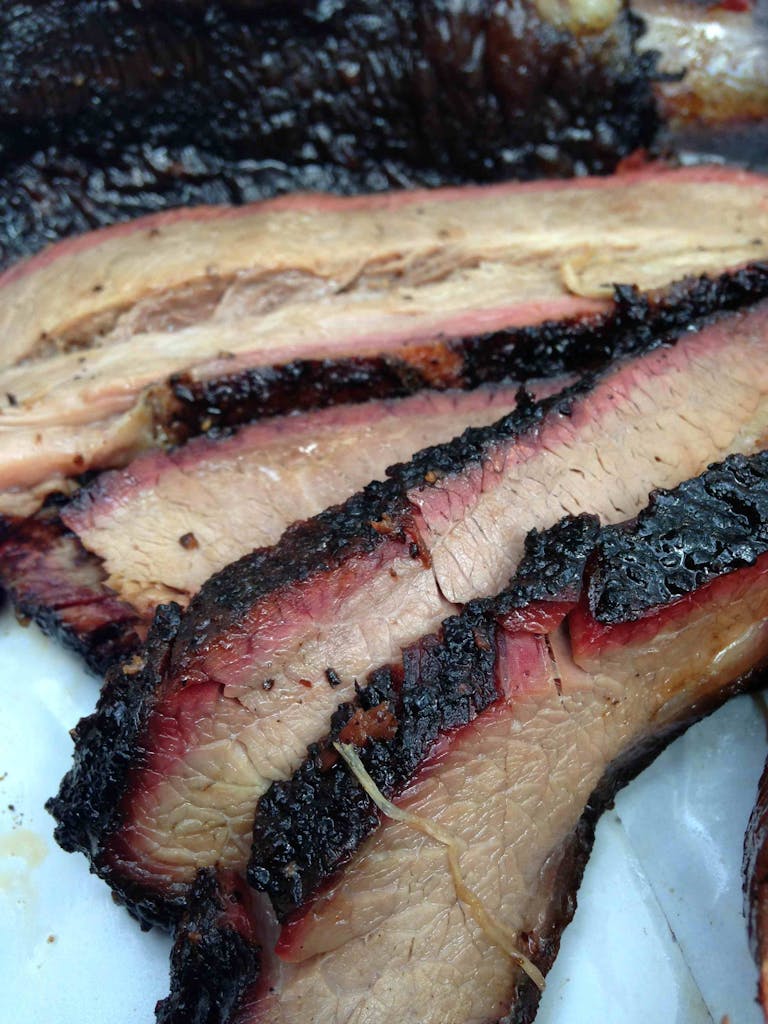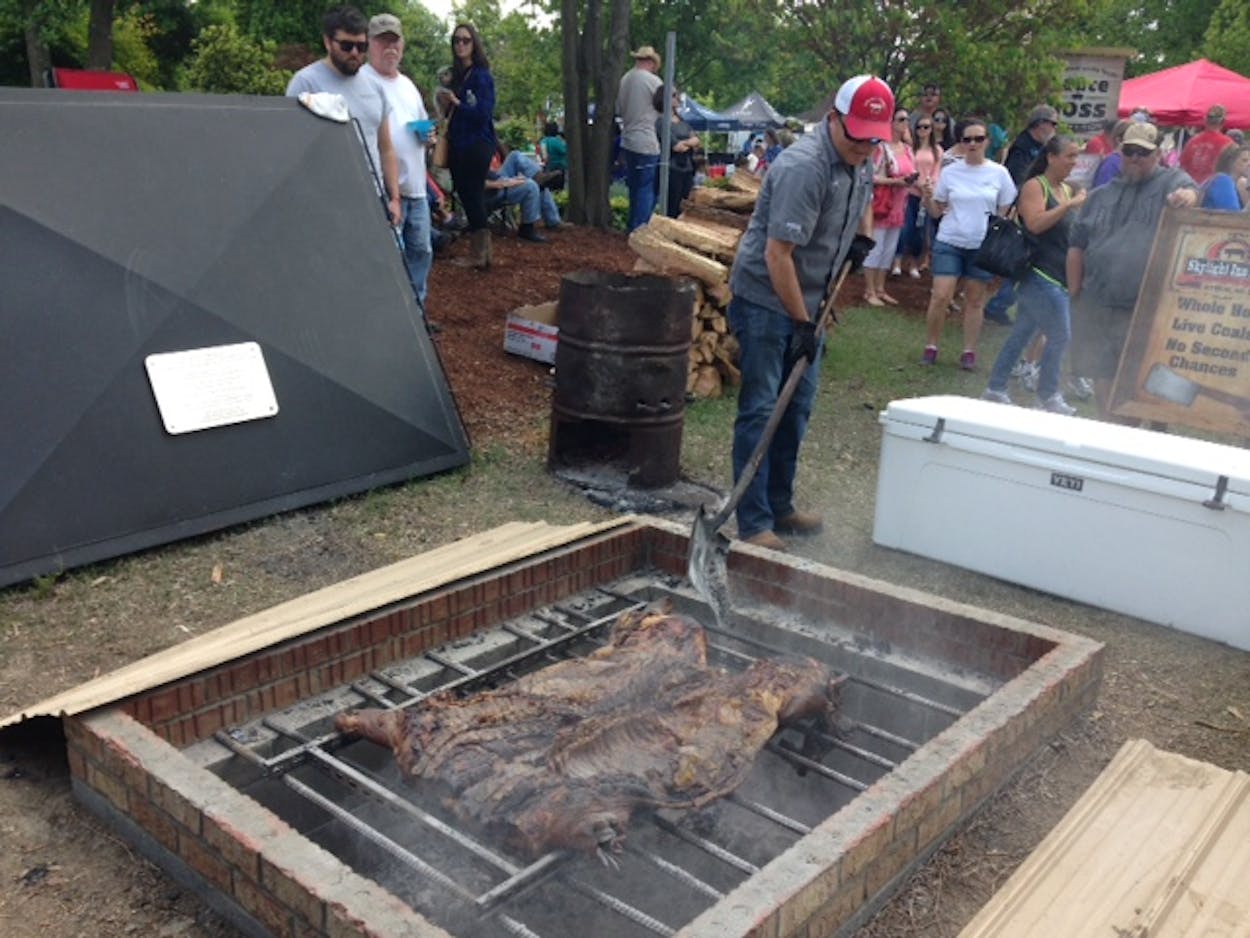Thanks to Calvin Trillin, barbecue is once again in the national spotlight. In his recent New Yorker article “In Defense of True ‘Cue,” Trillin highlighted True ‘Cue, an organization that campaigns for what they designate as “Real Barbecue,” while decrying what it refers to as “Faux ‘Cue,” meat sold as barbecue that isn’t cooked with wood. The use of those terms to define barbecue–true vs. faux–has put some in the barbecue world on the defensive.
Carey Bringle of Peg Leg Porker in Nashville struck back via a Facebook post. He cooks ribs, pork shoulders, and chicken (all of which I like very much) at his restaurant on an Ole Hickory rotisserie smoker. It’s a smoker with gas-assist, but wood is the primary fuel. Bringle’s barbecue uses modern technology, but he’s unhappy with the suggestion that his barbecue is any less real than someone using a stick burner. He explained his frustrations to me, saying, “Critique my food all you want. It’s about the end product. Just don’t tell me how to get there.” Bringle also bristled that the True ‘Cue folks want to create a black-and-white definition of real barbecue, telling them, “if you didn’t invent fire, you don’t own barbecue.”

I called John Shelton Reed, one of the founders of True ‘Cue, to congratulate him on his organization’s recent popularity (I am listed as a patron, with my permission, on the True ‘Cue website), and to get his reaction to Bringle’s comments. “I think if he read what we said about real barbecue on our website he wouldn’t come to the conclusion that we’re disrespecting him,” Reed told me. He doesn’t consider Bringle’s rotisserie-cooked barbecue to be a faux version of the craft, but he also wasn’t sure if a joint that cooks solely on gas-assist rotisseries could get the True ‘Cue certification. It exists in a sort of gray area, that True ‘Cue loosely describes as crossing “the line between True ‘Cue and faux ‘cue.” It’s the type of middle ground that doesn’t exist so much in True ‘Cue’s home state.
True ‘Cue was born in North Carolina where whole hogs and pork shoulders are cooked over wood coals or they’re not. Those barbecue joints that forgo the wood prepare the meat in ovens fueled only by gas burners or electric heating elements. “Oven-cooked” isn’t an unfairly loaded adjective; it is the whole truth and nothing but the truth. They don’t really deal with hybrid cookers in the Carolinas. Gas whole-hog cookers don’t use a single stick of wood to cook the meat. The flavor comes from the pork and the sauce, not wood. This made it easy to identify “real barbecue” from those cooking in ovens.
Southern Prides and Ole Hickory smokers are in a different category. Say what you want about gas-fired rotisseries, but they still rely on wood for the majority of the cook time–and, most imperatively, for flavor. Many in the industry, like Cattelack Barbecue in Dallas, turn off the gas entirely in their Ole Hickory smokers once the wood fire is lit. That means there is a significant gray area that True ‘Cue is going to need to address before they can be taken seriously outside of their friendly Carolina confines where methods are much more stridently black-and-white.

This isn’t the only challenge True ‘Cue will face; certifications will likely be done based on the word of the pitmaster that wood is their primary fuel. Aware of this issue, Reed assured me that “if folks cheat to win our love, they’ll roast in hell for it.”
As for Bringle, once he calmed down, the germ of his argument seems to be about semantics. Rather than calling barbecue either true or faux, he suggests changing the name to something less inflammatory like “Certified Wood-Only Cooked.” He sees no need for a barbecue judge and jury.
Bringle was also defiant, saying “We don’t need you as our savior.” That was a shot at writers who don’t run barbecue joints, and it’s a claim that no doubt applies to the popular Peg Leg Porker restaurant. True, it doesn’t need any help.
But there are plenty of American barbecue traditions that do. I’ve written about how the Hill Country-style of barbecue that could use a boost. Bringle’s friend and fellow Nashville barbecue joint owner Pat Martin of Martin’s Bar-B-Que Joint knows of one too: whole hog cooking in West Tennessee. Martin keeps this method alive in all three of his restaurants, where whole hogs are cooked over wood coals. He does this as an homage to his barbecue roots in West Tennessee where the art of wood-cooked whole hog is dying off. You might call Martin’s very visible whole hog technique (the pits are basically in the middle of his restaurant dining rooms) an awareness campaign for West Tennessee whole hog, which is very much in need of a savior.
With eyes on expansion outside of hog country, True ‘Cue has some work to do to clarify its mission. Co-founder Dan Levine told Trillin in his article, “We’re not fanatics. We just think there’s one right way to do things. Otherwise, it’s just oven-roasted pork.” That sounds a whole lot like they want to define what barbecue isn’t, which is a dangerous position for some, ahem, hogmatic North Carolinians to bring into Texas. I’ve often said that if we listened to everyone’s personal opinion about what is not barbecue, we’d be left with no barbecue.
My hope is that True ‘Cue maintains a focus on its work advocating for hardworking pitmasters in need of recognition and for consumers looking for an authentic meal. As a once and future tourist through the Carolinas and whole hog barbecue country, I applaud the organization’s work to raise awareness of the region’s signature barbecue cuisine, and to help revitalize it. I could’ve used True Cue’s guidance when I wasted a few stops during a past Carolina trips eating oven-roasted pork with vinegar sauce that was called barbecue, but steering any barbecue lover away from the rotisserie-smoked ribs at Peg Leg Porker is a step in the wrong direction. I hope that True ‘Cue broadens its definition to account for nuance, shades of gray, and various permutations of a given region’s cooking styles. That way we’ll all have more “true” barbecue to choose from, however you define it.








